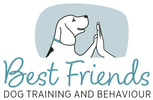A marker pinpoints a moment in time and
helps your dog learn
A marker pinpoints or “marks" the precise behaviour that we want to reinforce. It tells your dog the exact moment when he has done the right thing. This helps our dogs to learn faster.
It's possible to train without a marker but using a marker can make training clearer for your dog. If you see behaviour such as leash biting, barking, checking out, sniffing, jumping up, etc., your dog is probably frustrated and confused and "acting out".
Markers are typically sounds, though you can also use a gesture or even a sensation, such as vibration, which can be helpful for dogs with hearing and/or sight impairment.
A marker is not the same as verbal praise when you might say "good boy" or "good job" after your dog has done something you like.
Marker sounds are usually one of two types –– verbal (such as a specific word or short phrase) or mechanical (such as a clicker).
But the sound you use is less important than your timing and consistency.
Here's the most important thing:
Your marker must occur BEFORE you begin to deliver the treat.
If you give the marker and the treat at the same time, your dog won’t make a strong association. Instead your movement will overshadow your marker sound—basically turning it into irrelevant background noise. We need to separate the click from any other movement we make, in order to make the click THE significant predictor of reinforcement to our dogs.
To help you get it right, insert a brief pause between your "mark" and the delivery of your treat. Keep your hands still in a "home position"and only move to get the treat after you have marked and then briefly paused. The sequence is:
Only slightly less important is the timing of your marker relative to your dog’s behaviour. The behaviour that is occurring as you mark is the behaviour that gets reinforced, so for brand new behaviors you want to:
Time your marker at the moment your dog completes the desired behaviour.
Your timing helps the dog to understand what behaviour is earning the treat.
Practice your timing with this video by 4Paws University.
It's possible to train without a marker but using a marker can make training clearer for your dog. If you see behaviour such as leash biting, barking, checking out, sniffing, jumping up, etc., your dog is probably frustrated and confused and "acting out".
Markers are typically sounds, though you can also use a gesture or even a sensation, such as vibration, which can be helpful for dogs with hearing and/or sight impairment.
A marker is not the same as verbal praise when you might say "good boy" or "good job" after your dog has done something you like.
Marker sounds are usually one of two types –– verbal (such as a specific word or short phrase) or mechanical (such as a clicker).
But the sound you use is less important than your timing and consistency.
Here's the most important thing:
Your marker must occur BEFORE you begin to deliver the treat.
If you give the marker and the treat at the same time, your dog won’t make a strong association. Instead your movement will overshadow your marker sound—basically turning it into irrelevant background noise. We need to separate the click from any other movement we make, in order to make the click THE significant predictor of reinforcement to our dogs.
To help you get it right, insert a brief pause between your "mark" and the delivery of your treat. Keep your hands still in a "home position"and only move to get the treat after you have marked and then briefly paused. The sequence is:
- Click (or say "yes")
- PAUSE
- Reach for treat
- Feed the dog
- Hand back to home position
Only slightly less important is the timing of your marker relative to your dog’s behaviour. The behaviour that is occurring as you mark is the behaviour that gets reinforced, so for brand new behaviors you want to:
Time your marker at the moment your dog completes the desired behaviour.
Your timing helps the dog to understand what behaviour is earning the treat.
Practice your timing with this video by 4Paws University.
- us know how it goes on the Facebook group

